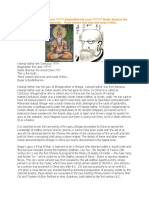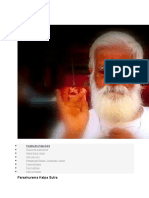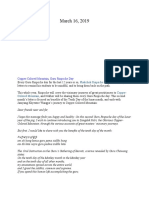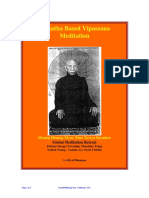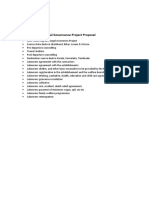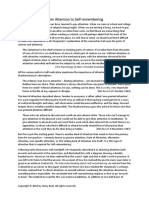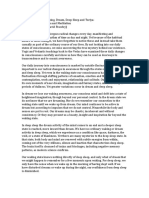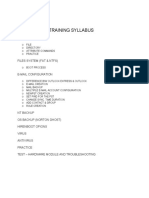Sufism
Sufism
Uploaded by
vivekgandhi7k7Copyright:
Available Formats
Sufism
Sufism
Uploaded by
vivekgandhi7k7Original Description:
Original Title
Copyright
Available Formats
Share this document
Did you find this document useful?
Is this content inappropriate?
Copyright:
Available Formats
Sufism
Sufism
Uploaded by
vivekgandhi7k7Copyright:
Available Formats
wjpmr, 2023, 9(5), 93-95 SJIF Impact Factor: 5.
922
Review Article
Amlani et al. WORLD JOURNAL OF PHARMACEUTICAL
World Journal of Pharmaceutical and Medical Research
ISSN 2455-3301
AND MEDICAL RESEARCH
www.wjpmr.com Wjpmr
CONCEPTUAL STUDY OF MIND IN AYURVEDA
Sadavrat Amlani*1, Pragya Singh2 and Anil Kumar Singh3
1
Assistant Professor, Department of Kayachikitsa, Shivalik Ayurvedic Medical College, Azamgarh.
2
Assistant Professor, Department of Samhita and Siddhanta, Guru Gorakhnath Institute of Medical Sciences (Faculty of
Ayurveda), Arogyadham, Balapar, Gorakhpur.
3
Professor and HOD, Department of Kayachikitsa, Shivalik Ayurvedic Medical College, Azamgarh.
*Corresponding Author: Sadavrat Amlani
Assistant Professor, Department of Kayachikitsa, Shivalik Ayurvedic Medical College, Azamgarh.
Article Received on 28/02/2023 Article Revised on 21/03/2023 Article Accepted on 11/04/2023
ABSTRACT
Ayurveda or the ancient Indian system of medicine, provides a comprehensive approach to the mental health that
incorporates the mind, body and soul. Mental health is described in ayurveda ranging from ancient texts like
Atharva veda to the subsequent treatise like Charaka Samhita, Sushruta Samhita, Ashtanga Hridayam and so on,
containing the causative factors, sign & symptoms and management of the mental disorders which includes Daiva
vyapashraya, Yukti vyapashraya and Satvavajaya chikitsa.
KEYWORDS: Manas roga, Mental disorders, Mental health.
INTRODUCTION (Intellectual errors) and Parinama (Time factors).[4]
Ayurveda or the ancient Indian system of medicine, These factors may be explained as follows:
provides a comprehensive approach to the mental health 1) Asatmyendriyartha samyoga[5] - It refers to the
that incorporates the mind, body and soul. Mental health atiyoga (excessive), ayoga (ineffective), or mithya yoga
is described in ayurveda ranging from ancient texts like (perverted use) of sense organs viz. karna (ears), twacha
Atharva veda to the subsequent treatise like Charaka (skin), akshi (eyes), jihwa (tongue) and naasa (nose).
Samhita, Sushruta Samhita, Ashtanga Hridayam and so a. Karna atiyoga: listening to loud sounds.
on, containing the causative factors, sign & symptoms b. Karna ayoga: not hearing any sound at all.
and management of the mental disorders. Ayurvedic c. Karna mithya yoga: listening harsh, fearful,
theory of mental health is based on the combination of spurious, unpleasant and distress signalling sounds.
the three gunas (Satva, Raja, Tama), Tridoshas (Vata, d. Twacha atiyoga: touching excessive hot or cold
Pitta, Kapha) and Panchamahabhutas (Akash, Vayu, objects.
Agni, Jala & Prithvi). The dynamic balance of these e. Twacha ayoga: not touching any object at all.
elements bestows a good mental health.[1] f. Twacha mithya yoga: contact of air with evil spirit
and noxious substances, untimely contact with oily,
Concept of Mind in Ayurveda hot or cold objects.
Mind is the one which helps in gaining knowledge. It has g. Akshi atiyoga: seeing excessively huge or
qualities of minuteness and oneness. And it is through microscopic objects.
the mind that the sense organs are able to indulge in their h. Akshi ayoga: not seeing any object at all.
respective sensory objects. Mind deals with various i. Akshi mithya yoga: seeing spiteful, horrible,
subjects like concerns, thoughts, goals, determination disgusting images, seeing from very far or near as
and all the other knowledge that is perceived through well as seeing vengeful images.
mind are to be considered as the subjects of mind.[2] The j. Jihwa atiyoga: excessive intake of any one rasa
functions of the mind include direction of the sensory (taste).
organs, controlling oneself from indulging in illicit k. Jihwa ayoga: No or little bit intake of any one rasa.
matters and thinking & determination.[3] l. Jihwa mithya yoga: intake of incompatible rasas.
m. Naasa atiyoga: sniffing very mild or strong odours.
Factors for vitiation of Mind n. Naasa ayoga: not sniffing at all.
The factors responsible for the vitiation of mind o. Naasa mithya yoga: sniffing rotten, toxic, noxious
includes: Asatmyendriyartha samyoga (Improper and unpleasant odours.
unification of mind with sense organs), Pragyaapradha
www.wjpmr.com │ Vol 9, Issue 5, 2023. │ ISO 9001:2015 Certified Journal │ 93
Amlani et al. World Journal of Pharmaceutical and Medical Research
2) Pragyaapradha[6] – Incorrect understanding by the CONCLUSION
intellect leading to inappropriate actions performed out In Ayurvedic texts, although there is no clear-cut
of it is known as intellectual errors. It includes classification of manas rogas (mental disorders) but each
suppression of natural urges, performing adventurous and every text has detailed descriptions about manas
tasks, excessive indulgence in sexual acts, improper (mind) and manas roga in the area of etiology and
intake of panchakarma procedures, giving up modesty treatment.
and virtue, insulting revered men & gods, knowingly
indulging in harmful activities, untimely visiting deserted REFERENCES
places, friendship with mean peoples, not following 1. Shastri Kashinatha, Chaturvedi Gorakhanatha,
sadvrittas, doing condemned acts influenced through editors Charaka Samhita, Vidyotini hindi
envy, arrogance, fear, anger, greed, attachment, insanity commentary, Sutrasthana chapter-1, Verse-48, Vol.
& illusions. I, 16th ed. Varanasi, Chaukhambha Bharti Academy,
2018; 19.
3) Parinama or Kaala[7]– Untimely acts in accordance 2. Shastri Kashinatha, Chaturvedi Gorakhanatha,
with diurnal and seasonal variations following atiyoga, editors Charaka Samhita, Vidyotini hindi
ayoga & mithya yoga of vata, pitta & kapha, which commentary, Sharirasthana chapter-1, Verse 19-20,
results in disease, aging and death. Vol. I, 16th ed. Varanasi, Chaukhambha Bharti
Academy, 2018; 804.
Diseases caused due to vitiation of Mind[8]- It includes 3. Shastri Kashinatha, Chaturvedi Gorakhanatha,
i. Unmada (Psychosis) editors Charaka Samhita, Vidyotini hindi
ii. Apasmara (Conversion disorders) commentary, Sharirasthana chapter-1, Verse 21,
iii. Atatvabhinivesha (obsessive compulsive disorders) Vol. I, 16th ed. Varanasi, Chaukhambha Bharti
iv. Bhrama (Illusion) Academy, 2018; 805.
v. Tandra (Drowsiness) 4. Shastri Kashinatha, Chaturvedi Gorakhanatha,
vi. Klama (Neurasthenia) editors Charaka Samhita, Vidyotini hindi
vii. Avsaad (Depression) commentary, Vimanasthana chapter-6, Verse 06,
viii. Aptantraka (Hysteria) Vol. I, 16th ed. Varanasi, Chaukhambha Bharti
ix. Chittodvega (Anxiety neurosis) Academy, 2018; 718.
x. Madatyaya (Alcohol intoxication) etc. 5. Shastri Kashinatha, Chaturvedi Gorakhanatha,
editors Charaka Samhita, Vidyotini hindi
Remedies of Mental illness – In ayurveda, there are commentary, Sharirasthana chapter-1, Verse 118-
three types of treatment modalities which includes: 126, Vol. I, 16th ed. Varanasi, Chaukhambha Bharti
1) Daiva Vyapashraya Chikitsa[9]: These methods Academy, 2018; 827.
promote assurance and favourable aptness. It includes 6. Shastri Kashinatha, Chaturvedi Gorakhanatha,
Mantra (chanting hymns), Aushadha (sacred herbs), editors Charaka Samhita, Vidyotini hindi
Mani (gem stones), Mangala bali (sacrifice), Upahara commentary, Sharirasthana chapter-1, Verse 103-
(offerings), Homa (worshipping), Niyama (regulations), 107, Vol. I, 16th ed. Varanasi, Chaukhambha Bharti
Prayaschita (atonement), Upvasa (fasting), Swastyayana Academy, 2018; 825.
(reading religious books), Pranipata (wishing sacred 7. Shastri Kashinatha, Chaturvedi Gorakhanatha,
ones) and Gamana (pilgrimage). editors Charaka Samhita, Vidyotini hindi
commentary, Sharirasthana chapter-1, Verse 111-
2) Yukti Vyapashraya Chikitsa[10]: It includes 115, Vol. I, 16th ed. Varanasi, Chaukhambha Bharti
management of diseases through aahar-vihaar (diet & Academy, 2018; 826.
lifestyle) & aushadha (drugs). Medicinal preparations 8. Shastri Kashinatha, Chaturvedi Gorakhanatha,
include editors Charaka Samhita, Vidyotini hindi
Single drugs like Brahmi, Mandookaparni, Guduchi, commentary, Nidanasthana chapter-7, Verse 04,
Shakhapushpi, Jatamansi etc. Vol. I, 16th ed. Varanasi, Chaukhambha Bharti
Formulations like Brahmi ghrita, Panchagavya Academy, 2018; 656.
ghrita, Kalyanaka ghrita, Vata kulantaka ras, 9. Shastri Kashinatha, Chaturvedi Gorakhanatha,
Smritisagar ras, Rasraja ras, Manas mitra vatakam editors Charaka Samhita, Vidyotini hindi
etc. commentary, Sutrasthana chapter-11, Verse-54, Vol.
I, 16th ed. Varanasi, Chaukhambha Bharti Academy,
3) Satvavajaya Chikitsa[11]: It aims in controlling the 2018; 238.
mind from indulging in unfair acts & deeds. Its 10. Shastri Kashinatha, Chaturvedi Gorakhanatha,
techniques include- Gyana (spiritual knowledge), editors Charaka Samhita, Vidyotini hindi
Vigyana (educating the patient), Dhairya (patience), commentary, Sutrasthana chapter-11, Verse-54, Vol.
Smriti (reviving the knowledge), and Samadhi I, 16th ed. Varanasi, Chaukhambha Bharti Academy,
(abstaining from over indulgence in materialistic world). 2018; 238.
11. Shastri Kashinatha, Chaturvedi Gorakhanatha,
editors Charaka Samhita, Vidyotini hindi
www.wjpmr.com │ Vol 9, Issue 5, 2023. │ ISO 9001:2015 Certified Journal │ 94
Amlani et al. World Journal of Pharmaceutical and Medical Research
commentary, Sutrasthana chapter-11, Verse-54, Vol.
I, 16th ed. Varanasi, Chaukhambha Bharti Academy,
2018; 238.
www.wjpmr.com │ Vol 9, Issue 5, 2023. │ ISO 9001:2015 Certified Journal │ 95
You might also like
- The Subtle Art of Not Giving a F*ck: A Counterintuitive Approach to Living a Good LifeFrom EverandThe Subtle Art of Not Giving a F*ck: A Counterintuitive Approach to Living a Good LifeRating: 4 out of 5 stars4/5 (5984)
- The Gifts of Imperfection: Let Go of Who You Think You're Supposed to Be and Embrace Who You AreFrom EverandThe Gifts of Imperfection: Let Go of Who You Think You're Supposed to Be and Embrace Who You AreRating: 4 out of 5 stars4/5 (1112)
- Never Split the Difference: Negotiating As If Your Life Depended On ItFrom EverandNever Split the Difference: Negotiating As If Your Life Depended On ItRating: 4.5 out of 5 stars4.5/5 (898)
- Hidden Figures: The American Dream and the Untold Story of the Black Women Mathematicians Who Helped Win the Space RaceFrom EverandHidden Figures: The American Dream and the Untold Story of the Black Women Mathematicians Who Helped Win the Space RaceRating: 4 out of 5 stars4/5 (932)
- Grit: The Power of Passion and PerseveranceFrom EverandGrit: The Power of Passion and PerseveranceRating: 4 out of 5 stars4/5 (619)
- Shoe Dog: A Memoir by the Creator of NikeFrom EverandShoe Dog: A Memoir by the Creator of NikeRating: 4.5 out of 5 stars4.5/5 (546)
- The Hard Thing About Hard Things: Building a Business When There Are No Easy AnswersFrom EverandThe Hard Thing About Hard Things: Building a Business When There Are No Easy AnswersRating: 4.5 out of 5 stars4.5/5 (357)
- Her Body and Other Parties: StoriesFrom EverandHer Body and Other Parties: StoriesRating: 4 out of 5 stars4/5 (831)
- Elon Musk: Tesla, SpaceX, and the Quest for a Fantastic FutureFrom EverandElon Musk: Tesla, SpaceX, and the Quest for a Fantastic FutureRating: 4.5 out of 5 stars4.5/5 (477)
- The Emperor of All Maladies: A Biography of CancerFrom EverandThe Emperor of All Maladies: A Biography of CancerRating: 4.5 out of 5 stars4.5/5 (275)
- The Little Book of Hygge: Danish Secrets to Happy LivingFrom EverandThe Little Book of Hygge: Danish Secrets to Happy LivingRating: 3.5 out of 5 stars3.5/5 (425)
- The World Is Flat 3.0: A Brief History of the Twenty-first CenturyFrom EverandThe World Is Flat 3.0: A Brief History of the Twenty-first CenturyRating: 3.5 out of 5 stars3.5/5 (2272)
- The Yellow House: A Memoir (2019 National Book Award Winner)From EverandThe Yellow House: A Memoir (2019 National Book Award Winner)Rating: 4 out of 5 stars4/5 (99)
- The Sympathizer: A Novel (Pulitzer Prize for Fiction)From EverandThe Sympathizer: A Novel (Pulitzer Prize for Fiction)Rating: 4.5 out of 5 stars4.5/5 (125)
- Devil in the Grove: Thurgood Marshall, the Groveland Boys, and the Dawn of a New AmericaFrom EverandDevil in the Grove: Thurgood Marshall, the Groveland Boys, and the Dawn of a New AmericaRating: 4.5 out of 5 stars4.5/5 (270)
- Team of Rivals: The Political Genius of Abraham LincolnFrom EverandTeam of Rivals: The Political Genius of Abraham LincolnRating: 4.5 out of 5 stars4.5/5 (235)
- A Heartbreaking Work Of Staggering Genius: A Memoir Based on a True StoryFrom EverandA Heartbreaking Work Of Staggering Genius: A Memoir Based on a True StoryRating: 3.5 out of 5 stars3.5/5 (232)
- On Fire: The (Burning) Case for a Green New DealFrom EverandOn Fire: The (Burning) Case for a Green New DealRating: 4 out of 5 stars4/5 (75)
- The Unwinding: An Inner History of the New AmericaFrom EverandThe Unwinding: An Inner History of the New AmericaRating: 4 out of 5 stars4/5 (45)
- Geshe Tenzin Namdak SessionsDocument6 pagesGeshe Tenzin Namdak Sessionsvivekgandhi7k7No ratings yet
- KalangiDocument35 pagesKalangivivekgandhi7k7100% (1)
- Heart Advicefor Practicing Dharmain Daily LifeDocument9 pagesHeart Advicefor Practicing Dharmain Daily Lifevivekgandhi7k7No ratings yet
- Samadhi Raja Sutra GampopaDocument7 pagesSamadhi Raja Sutra Gampopavivekgandhi7k7No ratings yet
- Mindfulness of Breathing: Pa-Auk Tawya SayadawDocument18 pagesMindfulness of Breathing: Pa-Auk Tawya Sayadawvivekgandhi7k7100% (1)
- Parasurama Kalpa SutraDocument12 pagesParasurama Kalpa Sutravivekgandhi7k7100% (2)
- Samatha: BuddhismDocument13 pagesSamatha: Buddhismvivekgandhi7k7100% (1)
- IP Addressing and Subnetting For New Users: TranslationsDocument18 pagesIP Addressing and Subnetting For New Users: Translationsvivekgandhi7k7100% (1)
- It Is Not The Subject or Object That Is The Cause of Suffering But The Mind, The Unconscious Which Is Full of Hatred and GreedDocument2 pagesIt Is Not The Subject or Object That Is The Cause of Suffering But The Mind, The Unconscious Which Is Full of Hatred and Greedvivekgandhi7k7No ratings yet
- Tenth Day Padma SambhavaDocument3 pagesTenth Day Padma Sambhavavivekgandhi7k7No ratings yet
- Kabir QuotesDocument1 pageKabir Quotesvivekgandhi7k7No ratings yet
- Samatha Based Vipassana Meditation: Moung Htaung Myay Zinn Tawya SayadawDocument26 pagesSamatha Based Vipassana Meditation: Moung Htaung Myay Zinn Tawya Sayadawvivekgandhi7k7No ratings yet
- Publisher's Desk: A Hindu View of MindfulnessDocument2 pagesPublisher's Desk: A Hindu View of Mindfulnessvivekgandhi7k7No ratings yet
- Inter-State Labour Legal Governance Project ProposalDocument1 pageInter-State Labour Legal Governance Project Proposalvivekgandhi7k7No ratings yet
- From Attention To Self RememberingDocument5 pagesFrom Attention To Self Rememberingvivekgandhi7k7No ratings yet
- Vamadeva Article 1216Document4 pagesVamadeva Article 1216vivekgandhi7k7No ratings yet
- Osho On Depression: Try To Become Aware When You Are SufferingDocument17 pagesOsho On Depression: Try To Become Aware When You Are Sufferingvivekgandhi7k7No ratings yet
- Questions Networking CcnaDocument4 pagesQuestions Networking Ccnavivekgandhi7k7No ratings yet
- Recurrent Neural Network Using LSTM ModelDocument15 pagesRecurrent Neural Network Using LSTM Modelvivekgandhi7k7No ratings yet
- Pratham ApproachDocument6 pagesPratham Approachvivekgandhi7k7No ratings yet
- CCNA Networking SyllabusDocument9 pagesCCNA Networking Syllabusvivekgandhi7k7No ratings yet
- Professional EthicsDocument41 pagesProfessional Ethicsvivekgandhi7k7100% (1)
- DesikastotraaniDocument212 pagesDesikastotraanivivekgandhi7k7No ratings yet
- One-Class Collective Anomaly Detection Based On Lstm-RnnsDocument13 pagesOne-Class Collective Anomaly Detection Based On Lstm-Rnnsvivekgandhi7k7No ratings yet









































